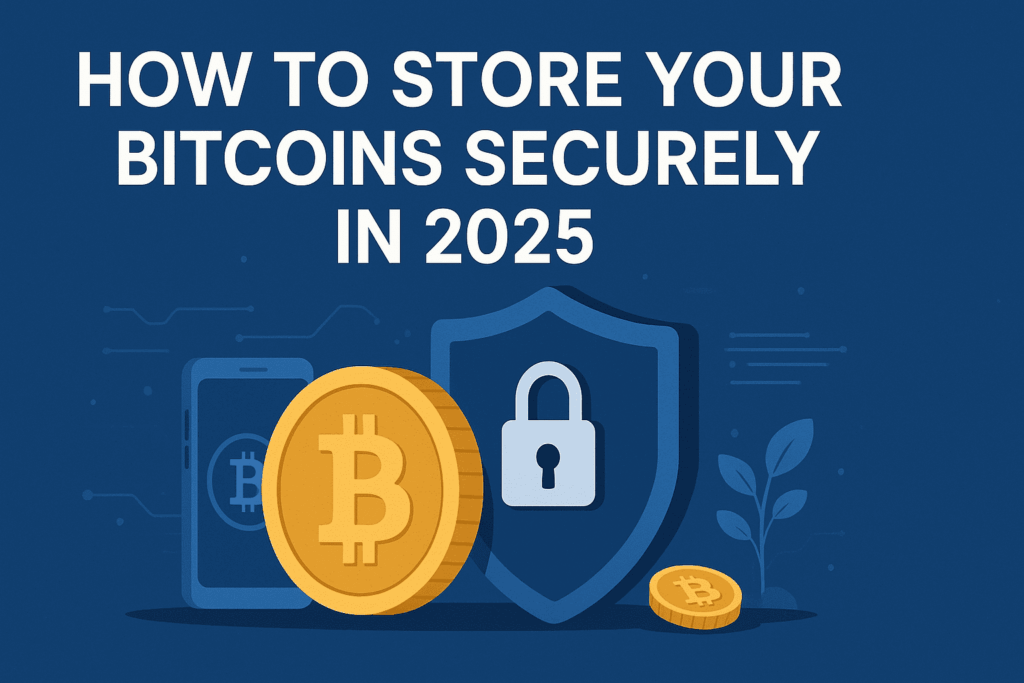
As Bitcoin continues its mainstream ascent in 2025—spurred by increasing institutional adoption, regulatory clarity, and global economic uncertainty—the need to securely store your BTC has never been more important. Whether you’re a first-time buyer or a long-time hodler, understanding how to store your bitcoins safely is crucial for protecting your investment.
This guide breaks down the different wallet types, latest best practices, and emerging technologies in Bitcoin storage, empowering you to choose the best option based on your risk profile and goals.
Why Secure Bitcoin Storage Matters in 2025
In traditional finance, your bank safeguards your savings. But in the world of crypto, “you are your own bank.” This means the responsibility of protecting your assets falls entirely on you.
From high-profile exchange hacks to phishing attacks and wallet mismanagement, stories of lost bitcoin are all too common. With the value of a single BTC reaching new highs in 2025, one mistake can be costly.
That’s why choosing the right storage method—and following security best practices—can mean the difference between long-term wealth and instant loss.
Types of Bitcoin Wallets
Bitcoin wallets fall into two broad categories: hot wallets and cold wallets. Let’s break each down:
1. Hot Wallets (Internet-Connected)
These are wallets connected to the internet and ideal for frequent transactions or smaller holdings.
a. Mobile Wallets
Apps like Trust Wallet, BlueWallet, and Phoenix allow users to send and receive BTC easily. Lightning Network integration has made these apps fast and ideal for microtransactions in 2025.
b. Desktop Wallets
Software such as Electrum or Sparrow Wallet provides more features like coin control and custom fee settings for advanced users.
c. Web Wallets
Exchange wallets (e.g., Binance, Coinbase) and browser-based wallets like Blockchain.com fall under this. While convenient, they rely on third-party custody.
Pros:
- Convenient and user-friendly
- Best for spending or trading
Cons:
- Vulnerable to hacking and malware
- Risk of losing funds if platform shuts down
2. Cold Wallets (Offline Storage)
These are wallets not connected to the internet, designed for long-term holding.
a. Hardware Wallets
Devices like the Ledger Nano X, Trezor Model T, and the new BitBox02 remain popular in 2025. These store your private keys in a secure chip offline.
b. Paper Wallets
A printed QR code containing your public and private keys. While outdated, some still use them for deep cold storage.
c. Air-Gapped Devices
Custom offline computers or phones with no network connections, used to sign transactions then broadcast from another device.
Pros:
- Immune to remote attacks
- Ideal for high-value storage
Cons:
- Less convenient for frequent use
- Requires backups and proper setup
How to Set Up a Secure Bitcoin Wallet in 2025
Let’s walk through the best practices for setting up and managing a wallet:
1. Choose the Right Wallet for Your Use Case
- For trading: Use hot wallets with 2FA.
- For long-term: Use cold storage (hardware or multisig).
2. Secure Your Recovery Phrase
Every non-custodial wallet gives you a seed phrase (usually 12 or 24 words). If someone gets access to this, they can steal your bitcoin.
Tips:
- Write it down and store in a waterproof/fireproof location.
- Never store it in plain text online (e.g., cloud, email).
- Consider steel backups like Cryptosteel or Billfodl.
3. Enable Advanced Security Features
- Use PIN codes or passphrases with hardware wallets.
- Enable two-factor authentication (2FA) on exchanges and mobile wallets.
- Use watch-only wallets for monitoring balance without exposing keys.
Cold Storage Options in 2025
With the rise in long-term investors and high-value holders, cold storage has evolved.
Multi-Signature Wallets (Multisig)
Platforms like Casa and Unchained Capital offer multisig solutions where multiple private keys (e.g., 2-of-3) are required to move funds. This reduces single point of failure.
Institutional Custody Solutions
For whales and institutions, custodial vaults like Anchorage and BitGo provide insured, regulatory-compliant storage.
Decentralized Custody Protocols
Protocols like Liana and Taproot Assets are helping users implement time-locked or inheritance-based storage using Bitcoin’s native scripting features.
Common Bitcoin Storage Mistakes (and How to Avoid Them)
❌ Storing on an Exchange Long-Term
Even major exchanges have been hacked (Mt. Gox, FTX, Coincheck). Always withdraw to your own wallet if you’re not actively trading.
❌ Screenshotting Your Seed Phrase
Mobile screenshots are easily synced to cloud backups, exposing your keys.
❌ Not Testing Wallet Restores
Always test a wallet restoration with a small amount before storing large sums.
Emerging Trends in Bitcoin Storage for 2025
1. Passkey-Enabled Wallets
New wallets are using biometric or hardware-based authentication to replace seed phrases, helping onboard mainstream users more safely.
2. AI-Secured Custody
Machine learning is being used to detect unusual behavior and flag potential breaches in custodial systems.
3. Lightning Network Wallets
Wallets like Phoenix and Breez now offer hybrid L1/L2 wallets, letting you manage on-chain and off-chain balances seamlessly.
4. Social Recovery Wallets
Protocols like Ethereum’s ERC-4337 are inspiring Bitcoin developers to build friend-or-family recovery options using multisig.
Conclusion
Storing your bitcoins securely in 2025 requires balancing convenience and security. For daily spending, a mobile wallet with Lightning support is practical. For long-term savings, a hardware or multisig setup provides peace of mind.
As the Bitcoin ecosystem matures, storage solutions will continue to evolve—giving you more control and confidence over your financial sovereignty.
Whether you’re holding $50 or $500,000 worth of BTC, how you store it will determine if you’ll be part of Bitcoin’s next chapter—or just another cautionary tale.
📚 Frequently Asked Questions (FAQ)
What is the safest way to store bitcoin in 2025?
A hardware wallet or multisig setup remains the safest for long-term storage. Combine it with proper seed phrase protection and offline backups.
Are paper wallets still safe?
They’re largely outdated and vulnerable to physical damage, printing errors, and lack of encryption. Hardware wallets are now the preferred alternative.
Can I store bitcoin on my phone?
Yes, but only small amounts. Mobile wallets are ideal for daily use, not long-term savings. Always enable PIN and biometric access.
What if I lose my seed phrase?
Without your seed phrase, recovery is impossible. That’s why secure, redundant backups (ideally offline and in separate locations) are critical.
What are multisig wallets and should I use them?
Multisig wallets require multiple keys to sign a transaction. They are excellent for joint accounts, businesses, and inheritance planning.
Are custodial wallets safe?
They can be safe, but you don’t control the private keys. Use only trusted, regulated platforms and avoid storing large balances with them.
What happens to my bitcoin if I die?
Unless you’ve set up inheritance planning (e.g., shared multisig or a legal trust), your BTC may be inaccessible. Plan ahead using social recovery or written instructions stored securely.

 Canada
Canada Deutsch
Deutsch Español
Español Português
Português



